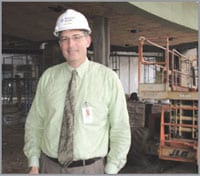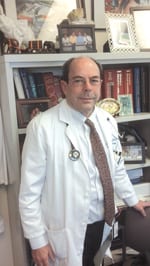Home Stretch Baystate’s Hospital of the Future Set for Spring Opening
When the Hospital of the Future opens to the public in March, only about half of the newly constructed building will be usable.
But without the hundreds of thousands of square feet of shell space included in the project, Baystate Medical Center might as well dub it the hospital of today, said Stanley Hunter, project executive. And that would miss the point.
“We call it the Hospital of the Future because we’ll be able to respond to the changing needs of health care in the coming years,” he said while taking the Healthcare News on a tour of the floors that will be bustling with patients this spring.
“The building itself is 640,000 square feet, which we’re fitting out in phases,” Hunter explained. “The first phase, just under half the building, will house our Heart and Vascular Program.”
The construction itself is within a month of completion, and patients will be able to use the facility in March, Hunter said. “The time period in between is for fitting out the building with equipment, training of staff, and Department of Public Health approvals in preparation for the opening. There are a lot of logistics to consider over the next four months in those areas.
“We’re excited that we’re on schedule,” he added. “We’ve always had that [March] date in mind, so it’s exciting that we’ll be able to keep to that. Construction started in mid-2008, and now, just over three years later, construction is still on track.”
What will follow, in late 2012, is the creation of a much larger, state-of-the-art Emergency Department in the new building, replacing a current ER that was designed to handle much less traffic than it does. Beyond that is deciding what will come of that aforementioned shell space.
But that’s a discussion for down the road. For now, Baystate officials are excited to unveil the results this ambitious, quarter-billion-dollar investment in the hospital’s — and community’s — future.
Heart of the Matter
As Hunter walked through the new Heart and Vascular space — an ICU floor for more serious patients, two regular inpatient floors, space for outpatient procedures, and a spacious operating suite — he pointed out technology such as the large monitors that loom above the surgical tables.
“Recent technology has improved our ability to do procedures on heart and vascular patients, and that includes a lot of image-guided surgery, which is being able to see the images on the screens as physicians are doing the surgery itself,” he explained.
Most people, however, will first notice the patient rooms, all of them single-occupancy.
“Our current rooms all double-occupancy,” Hunter said. “But studies show that single-occupancy rooms create an environment for better care and promote patient healing, so that’s going to be one large advantage for patients.
“There are also a lot more opportunities for family interaction with patients, family involvement in care, and making that transfer of care from the doctor and the clinical team to the family, so that when they leave they’re able to have a lot more insight into the care of the patient. There’s also a family area in each room, and family members will be able to stay overnight.”
The hospital is also installing the latest in telemetry and monitoring equipment, as well as the advanced electronic systems already in use to streamline drug prescribing and reduce medication errors.
Outside those hallways, Hunter said, “another thing we’re doing is remodeling the entry to the hospital. It’s sized and configured in a way that, when people come into the hospital, it’s a much clearer entry,” one that funnels patients from a central information desk to either the Daly building or the new structure. Parking has also been reconfigured, with much of Baystate’s north-side employee parking moved off-site to make room for more spaces for patients and visitors.
The second phase of the Hospital of the Future expansion, set to open in the fall of 2012, is a new Emergency Department.
“That was really a response to what our senior leadership heard from the community, from donors, and from staff — that the Emergency Department was greatly in need of upgrading,” Hunter said.
“We’ve been working with clinicians to design a contemporary space that meets the needs of patients,” he continued, adding that the hospital is also working to upgrade the technology and telecommunications systems used in that space.
“The Emergency Department will be three times bigger than it is now, with a dedicated children’s area and new trauma rooms where the most severe patients will be handled right away,” he explained. “The current Emergency Department was built in the ’80s for a much lower patient volume than what they’re experiencing now, so this will be built to the current patient volumes.”
Baystate is still trying to determine what to do with space in the current hospital that will be vacated when the Heart and Vascular Program, ER, and other services move to the new building. In addition, the Porter building, which had been used most recently for administrative offices, was torn down to make room for the Hospital of the Future expansion, which looms over Chestnut Street.
Lean and Green
The new building is modern in more ways than one. In addition to how it meets the needs of patients, Baystate engineered several ‘green’ touches. Skylights will bring plenty of natural daylight to interior spaces, reducing energy requirements.
In addition, energy-efficient lighting will be used. Sensors will rely on daylight wherever possible, and lower lighting levels at night. Patient rooms and family areas will be located along exterior walls to maximize access to natural light.
Meanwhile, high-quality window systems will assist with insulation, and the building’s cooling and air-handling systems will be energy-efficient. Baystate has also scheduled large tree plantings along the main road and is constructing a green roof accessible at the third floor but visible from dozens of rooms on higher floors as well.
“It’s an outdoor space between the buildings with a walking trail and benches so that patients, family members, and staff can get outside and get refreshed,” Hunter said. “It’s an amenity to be able to get out there in the sun on nice days.”
Even for those rooms that only overlook the area, “it’s an attractive feature to look out on instead of having a black rubber roof,” he noted. “And there are also environmental aspects; it helps us with temperature control and water conservation, because we collect the water for irrigation.”
Hunter said the project has injected some green of another kind into the area’s construction industry, with between 250 and 300 workers on site daily — about 70{06cf2b9696b159f874511d23dbc893eb1ac83014175ed30550cfff22781411e5} of them based in Springfield or the Pioneer Valley.
“We’ve been able to keep these jobs local because, especially in these times, we know there’s an interest in keeping work local in such an important project for the area.”
That work will eventually slow down, however, and a brand-new building will begin to fill with furniture, equipment, and hospital staff — and the future of Baystate Medical Center will begin in earnest.



Comments are closed.